Inside NASA's 5-month fight to save the Voyager 1 mission in interstellar space

After working for five months to re-establish communication with the farthest-flung human-made object in existence, NASA announced this week that the Voyager 1 probe had finally phoned home.
For the engineers and scientists who work on NASA’s longest-operating mission in space, it was a moment of joy and intense relief.
“That Saturday morning, we all came in, we’re sitting around boxes of doughnuts and waiting for the data to come back from Voyager,” said Linda Spilker, the project scientist for the Voyager 1 mission at NASA’s Jet Propulsion Laboratory in Pasadena, California. “We knew exactly what time it was going to happen, and it got really quiet and everybody just sat there and they’re looking at the screen.”
When at long last the spacecraft returned the agency’s call, Spilker said the room erupted in celebration.
“There were cheers, people raising their hands,” she said. “And a sense of relief, too — that OK, after all this hard work and going from barely being able to have a signal coming from Voyager to being in communication again, that was a tremendous relief and a great feeling.”

The problem with Voyager 1 was first detected in November . At the time, NASA said it was still in contact with the spacecraft and could see that it was receiving signals from Earth. But what was being relayed back to mission controllers — including science data and information about the health of the probe and its various systems — was garbled and unreadable.
That kicked off a monthslong push to identify what had gone wrong and try to save the Voyager 1 mission.
Spilker said she and her colleagues stayed hopeful and optimistic, but the team faced enormous challenges. For one, engineers were trying to troubleshoot a spacecraft traveling in interstellar space , more than 15 billion miles away — the ultimate long-distance call.
“With Voyager 1, it takes 22 1/2 hours to get the signal up and 22 1/2 hours to get the signal back, so we’d get the commands ready, send them up, and then like two days later, you’d get the answer if it had worked or not,” Spilker said.

The team eventually determined that the issue stemmed from one of the spacecraft’s three onboard computers. Spilker said a hardware failure, perhaps as a result of age or because it was hit by radiation, likely messed up a small section of code in the memory of the computer. The glitch meant Voyager 1 was unable to send coherent updates about its health and science observations.
NASA engineers determined that they would not be able to repair the chip where the mangled software is stored. And the bad code was also too large for Voyager 1's computer to store both it and any newly uploaded instructions. Because the technology aboard Voyager 1 dates back to the 1960s and 1970s, the computer’s memory pales in comparison to any modern smartphone. Spilker said it’s roughly equivalent to the amount of memory in an electronic car key.
The team found a workaround, however: They could divide up the code into smaller parts and store them in different areas of the computer’s memory. Then, they could reprogram the section that needed fixing while ensuring that the entire system still worked cohesively.
That was a feat, because the longevity of the Voyager mission means there are no working test beds or simulators here on Earth to test the new bits of code before they are sent to the spacecraft.
“There were three different people looking through line by line of the patch of the code we were going to send up, looking for anything that they had missed,” Spilker said. “And so it was sort of an eyes-only check of the software that we sent up.”
The hard work paid off.
NASA reported the happy development Monday, writing in a post on X : “Sounding a little more like yourself, #Voyager1.” The spacecraft’s own social media account responded , saying, “Hi, it’s me.”
So far, the team has determined that Voyager 1 is healthy and operating normally. Spilker said the probe’s scientific instruments are on and appear to be working, but it will take some time for Voyager 1 to resume sending back science data.
Voyager 1 and its twin, the Voyager 2 probe, each launched in 1977 on missions to study the outer solar system. As it sped through the cosmos, Voyager 1 flew by Jupiter and Saturn, studying the planets’ moons up close and snapping images along the way.
Voyager 2, which is 12.6 billion miles away, had close encounters with Jupiter, Saturn, Uranus and Neptune and continues to operate as normal.
In 2012, Voyager 1 ventured beyond the solar system , becoming the first human-made object to enter interstellar space, or the space between stars. Voyager 2 followed suit in 2018.
Spilker, who first began working on the Voyager missions when she graduated college in 1977, said the missions could last into the 2030s. Eventually, though, the probes will run out of power or their components will simply be too old to continue operating.
Spilker said it will be tough to finally close out the missions someday, but Voyager 1 and 2 will live on as “our silent ambassadors.”
Both probes carry time capsules with them — messages on gold-plated copper disks that are collectively known as The Golden Record . The disks contain images and sounds that represent life on Earth and humanity’s culture, including snippets of music, animal sounds, laughter and recorded greetings in different languages. The idea is for the probes to carry the messages until they are possibly found by spacefarers in the distant future.
“Maybe in 40,000 years or so, they will be getting relatively close to another star,” Spilker said, “and they could be found at that point.”
Denise Chow is a reporter for NBC News Science focused on general science and climate change.
- Skip to main content
- Keyboard shortcuts for audio player

Well, hello, Voyager 1! The venerable spacecraft is once again making sense

Nell Greenfieldboyce

Members of the Voyager team celebrate at NASA's Jet Propulsion Laboratory after receiving data about the health and status of Voyager 1 for the first time in months. NASA/JPL-Caltech hide caption
Members of the Voyager team celebrate at NASA's Jet Propulsion Laboratory after receiving data about the health and status of Voyager 1 for the first time in months.
NASA says it is once again able to get meaningful information back from the Voyager 1 probe, after months of troubleshooting a glitch that had this venerable spacecraft sending home messages that made no sense.
The Voyager 1 and Voyager 2 probes launched in 1977 on a mission to study Jupiter and Saturn but continued onward through the outer reaches of the solar system. In 2012, Voyager 1 became the first spacecraft to enter interstellar space, the previously unexplored region between the stars. (Its twin, traveling in a different direction, followed suit six years later.)
Voyager 1 had been faithfully sending back readings about this mysterious new environment for years — until November, when its messages suddenly became incoherent .

NASA's Voyager 1 spacecraft is talking nonsense. Its friends on Earth are worried
It was a serious problem that had longtime Voyager scientists worried that this historic space mission wouldn't be able to recover. They'd hoped to be able to get precious readings from the spacecraft for at least a few more years, until its power ran out and its very last science instrument quit working.
For the last five months, a small team at NASA's Jet Propulsion Laboratory in California has been working to fix it. The team finally pinpointed the problem to a memory chip and figured out how to restore some essential software code.
"When the mission flight team heard back from the spacecraft on April 20, they saw that the modification worked: For the first time in five months, they have been able to check the health and status of the spacecraft," NASA stated in an update.
The usable data being returned so far concerns the workings of the spacecraft's engineering systems. In the coming weeks, the team will do more of this software repair work so that Voyager 1 will also be able to send science data, letting researchers once again see what the probe encounters as it journeys through interstellar space.

After a 12.3 billion-mile 'shout,' NASA regains full contact with Voyager 2
- interstellar mission
Subscribe or renew today
Every print subscription comes with full digital access
Science News
‘humanity’s spacecraft’ voyager 1 is back online and still exploring.
After five months of glitching, the spacecraft is talking to Earth again from interstellar space

The Voyager 1 spacecraft (illustrated) is back online after a few months of transmitting garbled data. It’s now poised to continue its exploration of interstellar space.
JPL-Caltech/NASA
Share this:
By Ramin Skibba
April 26, 2024 at 11:45 am
After months of challenging trouble-shooting and suspenseful waiting, Voyager 1 is once again talking to Earth.
The aging NASA spacecraft, about 24 billion kilometers from home, began transmitting garbled data in November. On April 20, NASA scientists got the probe back online after uploading new flight software to work around a chunk of onboard computer memory that had failed. They’re now receiving data about the spacecraft’s health and hope to hear from its science instruments again in a few weeks, says Suzanne Dodd, the mission’s project manager at NASA’s Jet Propulsion Laboratory in Pasadena, Calif.
That means the iconic craft could be on a path to recovery — and to continue its exploration of interstellar space.
Launched in 1977, Voyager 1 briefly visited Jupiter and Saturn before eventually departing the solar system. It and its twin, Voyager 2, are the longest-operating space probes, now tasked with studying far-flung solar particles and cosmic rays. In particular, the probes have been monitoring the changing of the sun’s magnetic field and the density of plasma beyond the solar system, yielding information about the farthest reaches of the sun’s influence .
“The spacecraft is really remarkable in its longevity. It’s incredible,” Dodd says. “We want to keep Voyager going as long as possible so we have this time record of these changes.”
Voyager 1 and 2, cruising along diverging paths, made history by crossing the heliopause in 2012 and 2018 , respectively ( SN: 9/12/13; SN: 12/10/18 ). At nearly 18 billion kilometers from the sun, that’s long been considered the outer extent of our star’s magnetic field and the solar wind, the boundary before interstellar space.
Since then, Dodd says, the science team has made some surprising findings ( SN: 11/4/19 ). For one, they’ve determined that the heliosphere, the huge bubble of space dominated by the solar wind, might not be spherical but have one or two tails, making it shaped like a comet or a croissant.
And thanks to Voyager, scientists now know that, despite expectations otherwise, the sun’s magnetic field and charged particles actually remain significant even beyond the heliopause, says David McComas, a Princeton University astrophysicist not involved in the mission.
Some theories predicted a serene environment in the distant oceans of interstellar space, but the Voyagers keep passing through waves of charged particles, indicating that the solar magnetic field still holds some sway there. What’s more, the probes’ data have shown how ripples in the field form bubbles at the edge of the solar system, which is more frothy and dynamic than expected.
Other missions have begun building on Voyager’s solar physics research. These include NASA’s Interstellar Boundary Explorer, or IBEX, and the Interstellar Mapping and Acceleration Probe, or IMAP, which is set to launch next year. Earth-orbiting IBEX has been measuring high-energy particles to map the heliosphere for 15 years, whereas IMAP will orbit between the sun and Earth, giving it an uninterrupted view of the sun as it monitors the galactic cosmic rays that manage to filter through the heliosphere.
“There’s a huge synergy between the Voyagers and both IBEX and IMAP,” says McComas, principal investigator of the latter two missions. “We were all really scared when Voyager 1 stopped phoning home.”
It will be decades until another mission could accomplish what the Voyagers have done. NASA’s New Horizons soared by Pluto in 2015 and kept going ( SN:8/9/18 ). It’s heading toward the edge of the solar system, but it’s cruising slowly and will run out of power before it can collect data beyond the heliopause.
The Voyagers can fly forever, but power for their instruments is waning. Over the next few years, NASA will shut some down to conserve energy for the rest.
That means Voyager 1’s days of collecting science data are numbered. “It’s a very beloved mission,” Dodd says. “It’s humanity’s spacecraft, and we need to take care of it.”
More Stories from Science News on Space

Separating science fact from fiction in Netflix’s ‘3 Body Problem’

Pluto’s heart-shaped basin might not hide an ocean after all

Our picture of habitability on Europa, a top contender for hosting life, is changing

Jupiter’s moon Io may have been volcanically active ever since it was born

50 years ago, scientists found a lunar rock nearly as old as the moon

How a sugar acid crucial for life could have formed in interstellar clouds

What Science News saw during the solar eclipse

During the awe of totality, scientists studied our planet’s reactions
Subscribers, enter your e-mail address for full access to the Science News archives and digital editions.
Not a subscriber? Become one now .
Voyager turns 45: What the iconic mission taught us and what's next
Can the first probe to visit Neptune and Uranus make it to its 50th anniversary?
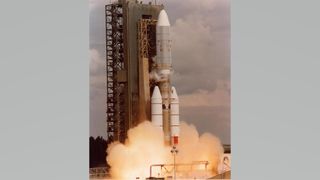
Forty-five years ago, on Aug. 20, 1977, NASA's Voyager 2 spacecraft launched from Cape Canaveral, Florida, on a Titan III-Centaur rocket, embarking on a "grand tour" of the solar system that would include visits to the Jupiter and Saturn systems and would make it the first spacecraft to visit the ice giants Uranus and Neptune and their moons.
Voyager 2 is now 12.1 billion miles (19.5 billion kilometers) away and still sending back data on the distant and unknown heliopause, and scientists are beginning to wonder how long the iconic space probe can keep going.
Designed to take advantage of a once-every-176-years alignment in the 1970s that made it possible for spacecraft to take gravity-assist slingshots from planet to planet across the solar system , the Voyager mission consisted of two probes. Voyager 2 was the first to launch, with Voyager 1 following two weeks later. Both carried the famous " Golden Record ," a 12-inch gold-plated copper disc containing sounds and images portraying the diversity of life and culture on Earth .
Now over 14.5 billion miles (23.3 billion km) away, Voyager 1 is the farthest artificial object from Earth. But Voyager 2 is arguably more iconic because of its incredible multidecade tour of the giant planets.
Related: Celebrate 45 years of Voyager with these amazing images of our solar system (gallery)
Voyager's "grand tour"
Though it launched second, Voyager 1 was so called because it was to reach Jupiter and Saturn first — in March 1979 and November 1980, respectively — before exiting the plane of the planets where it took the famous "Pale Blue Dot" photo . Voyager 2 visited four planets: Jupiter in July 1979, Saturn in August 1981, Uranus in January 1986 and Neptune in August 1989.
"Both Voyager 1 and Voyager 2 provided tremendous legacies for planetary exploration," Jonathan Lunine, a planetary scientist and physicist at Cornell University who is working on the Juno , Europa Clipper and James Webb Space Telescope missions, told Space.com. "Not only in what they accomplished in terms of science, but also demonstrating that it was really possible to explore the outer solar system with a couple of spacecraft."
Get the Space.com Newsletter
Breaking space news, the latest updates on rocket launches, skywatching events and more!
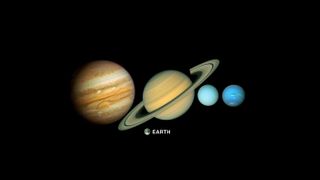
What did the Voyager probes reveal?
Voyager's discoveries are the stuff of legend among planetary scientists, many of whom still rely on the unique images from the spacecraft's wide-angle and narrow-angle cameras. The probes spotted volcanoes on Jupiter's moon Io , discovered that Jupiter's Great Red Spot is an Earth-size storm and found that the gas giant has faint rings. They studied Saturn's rings ; saw the giant moon Titan's thick, Earth-like atmosphere; and revealed the tiny moon Enceladus to be geologically active.
Voyager 2 alone then visited Uranus and Neptune. The spacecraft's first-ever images of Uranus revealed dark rings, the planet's tilted magnetic field and its geologically active moon Miranda. Neptune, meanwhile, was also discovered to have rings and many more moons than scientists initially thought. We also got to see Triton , a geologically active moon that is orbiting "backward" and, like Pluto , is now believed to be a captured dwarf planet from the Kuiper Belt .
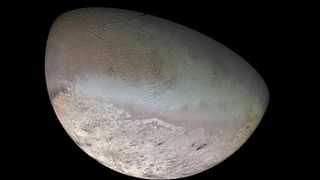
Voyager as a catalyst
In addition to making groundbreaking discoveries, the Voyager mission helped scientists determine what merited deeper exploration. The mission revealed Jupiter to be an incredibly complex planet, thus spurring NASA to launch the Galileo mission in 1989 and the Juno mission in 2011. The Voyager probes' work also helped to inspire the iconic Cassini mission to Saturn.
"Voyager 1's close flyby of Titan was the catalyst for the wonderful Cassini mission to Saturn and its Huygens probe," Lunine said. The Huygens probe landed on the surface of Titan in 2005 and sent back an incredible video .
Voyager 2 has also been a catalyst for investigations into the role of the ice giant planets — not only in the solar system but also in distant star systems, since most of the exoplanets found so far are roughly the size of Neptune and Uranus.
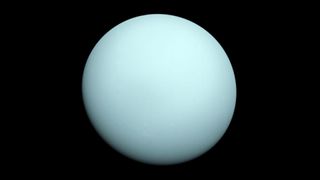
Voyager and NASA today
NASA has spent decades following up on the Voyager missions, and those efforts continue today. The space agency's Dragonfly mission will reach Titan, Saturn's largest moon, in 2034, while Europa Clipper will study Jupiter's ocean moon, first imaged by Voyager, starting in 2030. In April, the National Academies Planetary Science Decadal Survey recommended that NASA send a $4.2 billion Uranus Orbiter and Probe mission to unveil the mysterious ice giant planet and its moons in the 2040s.
It's the latest mission that's a direct consequence of Voyager 2's brief visit to the Uranus system in January 1986. "Voyager 2's flyby of Uranus was a bull's-eye — it went directly through the plane of the moons' orbits because of the orientation of Uranus' axis to the sun ," Lunine said. That made it unlike flybys at other planets, where the probes were able to visit one moon after another. "Voyager 2 got very brief images from these moons, so they're largely unexplored," Lunine said.
Ariel and Miranda, in particular, are thought to be ocean worlds and so would be specifically targeted by the Uranus Orbiter and Probe. "It's been 45 years since the launch of Voyager 1 and Voyager 2, and here we are now finally talking about a Uranus Orbiter and Probe mission," Lunine said. "It seems like a long time because these missions take so long to conceive of, fund, build, launch and execute, but it all comes from the intriguing peeks that we got from Voyager 2."
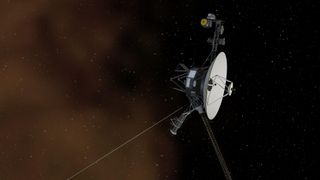
How long will Voyager last?
Both Voyager 1 and Voyager 2 still communicate with NASA's Deep Space Network (which itself was created to communicate with Voyager 2 at Uranus and Neptune), receiving routine commands and occasionally transmitting data to Earth. "We are still getting data from Voyager," Stamatios Krimigis, principal investigator for the Voyager 1 and 2 probes and the Voyager Interstellar Mission, said during a news conference held at COSPAR 22 in July. "We're looking forward to getting data for probably another five or six years."
— What's next for NASA's Voyager 2 in interstellar space?
— Scientists' predictions for the long-term future of the Voyager Golden Records will blow your mind
— NASA's twin Voyager probes are nearly 45 — and facing some hard decisions
Around the mid- to late 2020s , the probes' scientific instruments will be entirely switched off, and eventually, the spacecraft will go cold and silent — but their journeys into interstellar space will continue indefinitely. "My motto is, I want to be here after Voyager passes on," said Krimigis, who is in his 80s. "But I'm not sure that's going to happen."
In around 300 years, Voyager 1 and 2 will enter the Oort cloud , the sphere of comets surrounding the solar system. About 30,000 years later, they'll exit the neighborhood and silently orbit the center of the Milky Way for millions of years.
Their scientific work may be almost over, but the Voyager spacecraft have only just begun their journeys into the cosmos.
Follow us on Twitter @Spacedotcom and on Facebook .
Join our Space Forums to keep talking space on the latest missions, night sky and more! And if you have a news tip, correction or comment, let us know at: [email protected].

Jamie is an experienced science, technology and travel journalist and stargazer who writes about exploring the night sky, solar and lunar eclipses, moon-gazing, astro-travel, astronomy and space exploration. He is the editor of WhenIsTheNextEclipse.com and author of A Stargazing Program For Beginners , and is a senior contributor at Forbes. His special skill is turning tech-babble into plain English.
Satellites watch as 4th global coral bleaching event unfolds (image)
Happy Earth Day 2024! NASA picks 6 new airborne missions to study our changing planet
Boeing Starliner astronauts conduct dress rehearsal ahead of May 6 launch (photos, video)
Most Popular
- 2 Meet the crew launching on Boeing's 1st Starliner astronaut flight
- 3 'Flash Gordon' returns to escape from a prison planet in new comic series
- 4 'Tiger stripes' on Saturn's moon Enceladus could reveal if its oceans are habitable
- 5 Astronomers finally know why stars born from the same cloud aren't identical twins
- Become A Member
- Gift Membership
- Kids Membership
- Other Ways to Give
- Explore Worlds
- Defend Earth
How We Work
- Education & Public Outreach
- Space Policy & Advocacy
- Science & Technology
- Global Collaboration
Our Results
Learn how our members and community are changing the worlds.
Our citizen-funded spacecraft successfully demonstrated solar sailing for CubeSats.
Space Topics
- Planets & Other Worlds
- Space Missions
- Space Policy
- Planetary Radio
- Space Images
The Planetary Report
The eclipse issue.
Science and splendor under the shadow.
Get Involved
Membership programs for explorers of all ages.
Get updates and weekly tools to learn, share, and advocate for space exploration.
Volunteer as a space advocate.
Support Our Mission
- Renew Membership
- Society Projects
The Planetary Fund
Accelerate progress in our three core enterprises — Explore Worlds, Find Life, and Defend Earth. You can support the entire fund, or designate a core enterprise of your choice.
- Strategic Framework
- News & Press
The Planetary Society
Know the cosmos and our place within it.
Our Mission
Empowering the world's citizens to advance space science and exploration.
- Explore Space
- Take Action
- Member Community
- Account Center
- “Exploration is in our nature.” - Carl Sagan
The Voyager missions
Highlights Voyager 1 and Voyager 2 launched in 1977 and made a grand tour of the solar system's outer planets. They are the only functioning spacecraft in interstellar space, and they are still sending back measurements of the interstellar medium. Each spacecraft carries a copy of the golden record, a missive from Earth to any alien lifeforms that may find the probes in the future.
What are the Voyager missions?
The Voyager program consists of two spacecraft: Voyager 1 and Voyager 2. Voyager 2 was actually launched first, in August 1977, but Voyager 1 was sent on a faster trajectory when it launched about two weeks later. They are the only two functioning spacecraft currently in interstellar space, beyond the environment controlled by the sun.
Voyager 2’s path took it past Jupiter in 1979, Saturn in 1981, Uranus in 1985, and Neptune in 1989. It is the only spacecraft to have visited Uranus or Neptune, and has provided much of the information that we use to characterize them now.
Because of its higher speed and more direct trajectory, Voyager 1 overtook Voyager 2 just a few months after they launched. It visited Jupiter in 1979 and Saturn in 1980. It overtook Pioneer 10 — the only other spacecraft in interstellar space thus far — in 1998 and is now the most distant artificial object from Earth.
How the Voyagers work
The two spacecraft are identical, each with a radio dish 3.7 meters (12 feet) across to transmit data back to Earth and a set of 16 thrusters to control their orientations and point their dishes toward Earth. The thrusters run on hydrazine fuel, but the electronic components of each spacecraft are powered by thermoelectric generators that run on plutonium. Each carries 11 scientific instruments, about half of which were designed just for observing planets and have now been shut off. The instruments that are now off include several cameras and spectrometers to examine the planets, as well as two radio-based experiments. Voyager 2 now has five functioning instruments: a magnetometer, a spectrometer designed to investigate plasmas, an instrument to measure low-energy charged particles and one for cosmic rays, and one that measures plasma waves. Voyager 1 only has four of those, as its plasma spectrometer is broken.
Jupiter findings
Over the course of their grand tours of the solar system, the Voyagers took tens of thousands of images and measurements that significantly changed our understanding of the outer planets.
At Jupiter, they gave us our first detailed ideas of how the planet’s atmosphere moves and evolves, showing that the Great Red Spot was a counter-clockwise rotating storm that interacted with other, smaller storms. They were also the first missions to spot a faint, dusty ring around Jupiter. Finally, they observed some of Jupiter’s moons, discovering Io’s volcanism, finding the linear features on Europa that were among the first hints that it might have an ocean beneath its surface, and granting Ganymede the title of largest moon in the solar system, a superlative that was previously thought to belong to Saturn’s moon Titan.
Saturn findings
Next, each spacecraft flew past Saturn, where they measured the composition and structure of Saturn’s atmosphere , and Voyager 1 also peered into Titan’s thick haze. Its observations led to the idea that Titan might have liquid hydrocarbons on its surface, a hypothesis that has since been verified by other missions. When the two missions observed Saturn’s rings, they found the gaps and waves that are well-known today. Voyager 1 also spotted three previously-unknown moons orbiting Saturn: Atlas, Prometheus, and Pandora.
Uranus and Neptune findings
After this, Voyager 1 headed out of the solar system, while Voyager 2 headed toward Uranus . There, it found 11 previously-unknown moons and two previously-unknown rings. Many of the phenomena it observed on Uranus remained unexplained, such as its unusual magnetic field and an unexpected lack of major temperature changes at different latitudes.
Voyager 2’s final stop, 12 years after it left Earth, was Neptune. When it arrived , it continued its streak of finding new moons with another haul of 6 small satellites, as well as finding rings around Neptune. As it did at Uranus, it observed the planet’s composition and magnetic field. It also found volcanic vents on Neptune’s huge moon Triton before it joined Voyager 1 on the way to interstellar space.
Interstellar space
Interstellar space begins at the heliopause, where the solar wind – a flow of charged particles released by the sun – is too weak to continue pushing against the interstellar medium, and the pressure from the two balances out. Voyager 1 officially entered interstellar space in August 2012, and Voyager 2 joined it in November 2018.
These exits were instrumental in enabling astronomers to determine where exactly the edge of interstellar space is, something that’s difficult to measure from within the solar system. They showed that interstellar space begins just over 18 billion kilometers (about 11 billion miles) from the sun. The spacecraft continue to send back data on the structure of the interstellar medium.
After its planetary encounters, Voyager 1 took the iconic “Pale Blue Dot” image , showing Earth from about 6 billion kilometers (3.7 billion miles) away. As of 2021 , Voyager 1 is about 155 astronomical units (14.4 billion miles) from Earth, and Voyager 2 is nearly 129 astronomical units (12 billion miles) away.
The golden records
Each Voyager spacecraft has a golden phonograph record affixed to its side, intended as time capsules from Earth to any extraterrestrial life that might find the probes sometime in the distant future. They are inscribed with a message from Jimmy Carter, the U.S. President at the time of launch, which reads: “This is a present from a small, distant world, a token of our sounds, our science, our images, our music, our thoughts and our feelings. We are attempting to survive our time so we may live into yours.”
The covers of the records have several images inscribed, including visual instructions on how to play them, a map of our solar system’s location with respect to a set of 14 pulsars, and a drawing of a hydrogen atom. They are plated with uranium – its rate of decay will allow any future discoverers of either of the records to calculate when they were created.
The records’ contents were selected by a committee chaired by Carl Sagan. Each contains 115 images, including scientific diagrams of the solar system and its planets, the flora and fauna of Earth, and examples of human culture. There are natural sounds, including breaking surf and birdsong, spoken greetings in 55 languages, an hour of brainwave recordings, and an eclectic selection of music ranging from Beethoven to Chuck Berry to a variety of folk music.
Learn more Voyager Mission Status Bulletin Archives Experience A Message From Earth - Inspired by the Voyager Golden Record Neptune, planet of wind and ice
Support missions like Voyager 1 and 2
Whether it's advocating, teaching, inspiring, or learning, you can do something for space, right now. Let's get to work.
For full functionality of this site it is necessary to enable JavaScript. Here are instructions on how to enable JavaScript in your web browser .

Two Voyager Spacecraft Still Going Strong After 20 Years
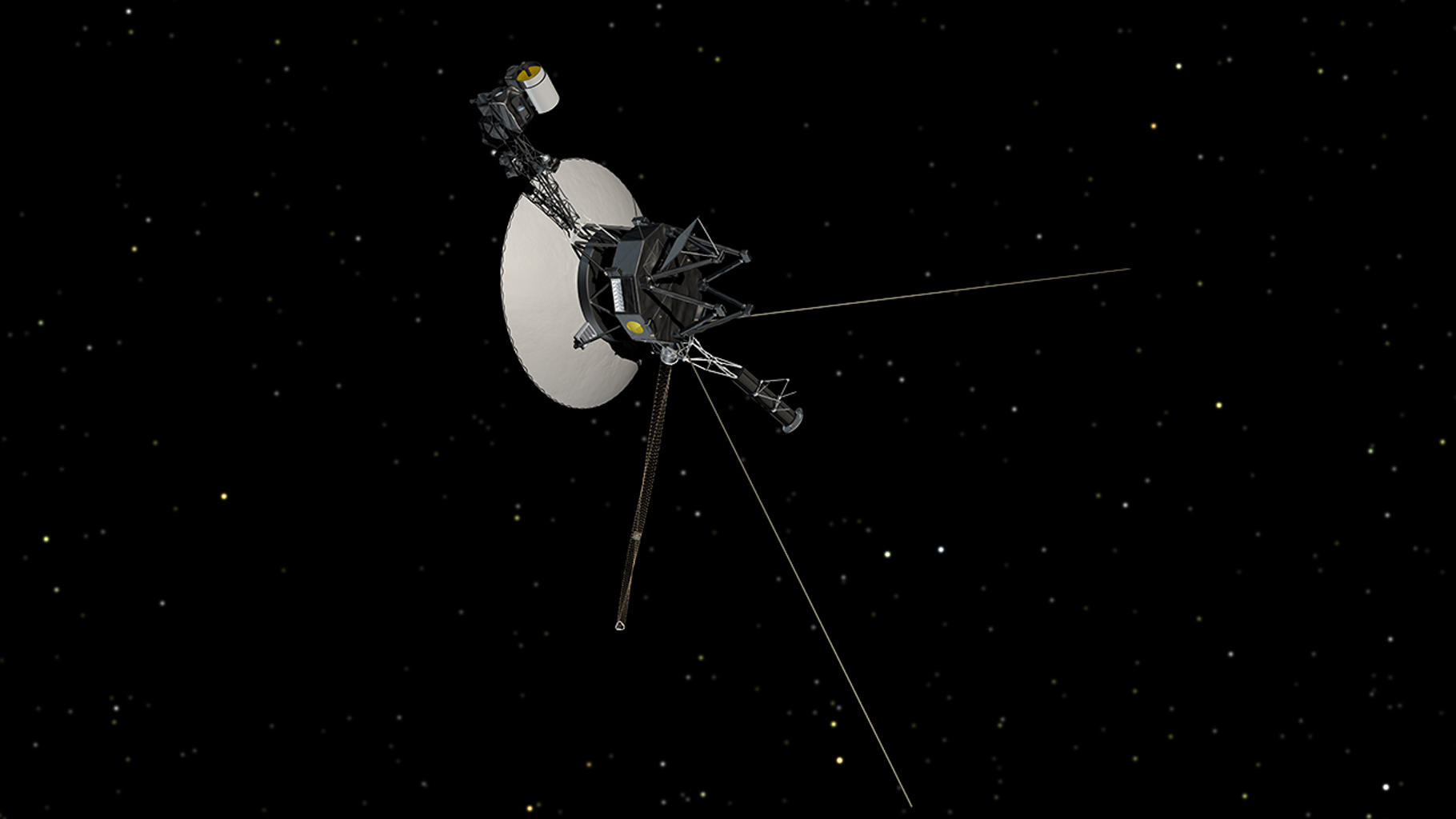
Twenty years after their launch and long after their planetary reconnaissance flybys were completed, both Voyager spacecraft are now gaining on another milestone -- crossing that invisible boundary that separates our solar system from interstellar space, the heliopause.
Since 1989, when Voyager 2 encountered Neptune, both spacecraft have been studying the environment of space in the outer solar system. Science instruments on both spacecraft are sensing signals that scientists believe are coming from the heliopause -- the outer most edge of the Sun's magnetic field that the spacecraft must pass through before they reach interstellar space.
"During their first two decades the Voyager spacecraft have had an unequaled journey of discovery. Today, even though Voyager 1 is now more than twice as far from the Sun as Neptune, their journey is only half over and more unique opportunities for discovery await the spacecraft as they head toward interstellar space," said Dr. Edward Stone, Voyager project scientist and director of NASA's Jet Propulsion Laboratory, Pasadena, CA. "The Voyagers owe their ability to operate at such great distances from the Sun to their nuclear electric power sources, which provide the electrical power they need to function."
The Voyagers owe their ability to operate at such great distances from the Sun to their nuclear electric power sources, which provide the electrical power they need to function.
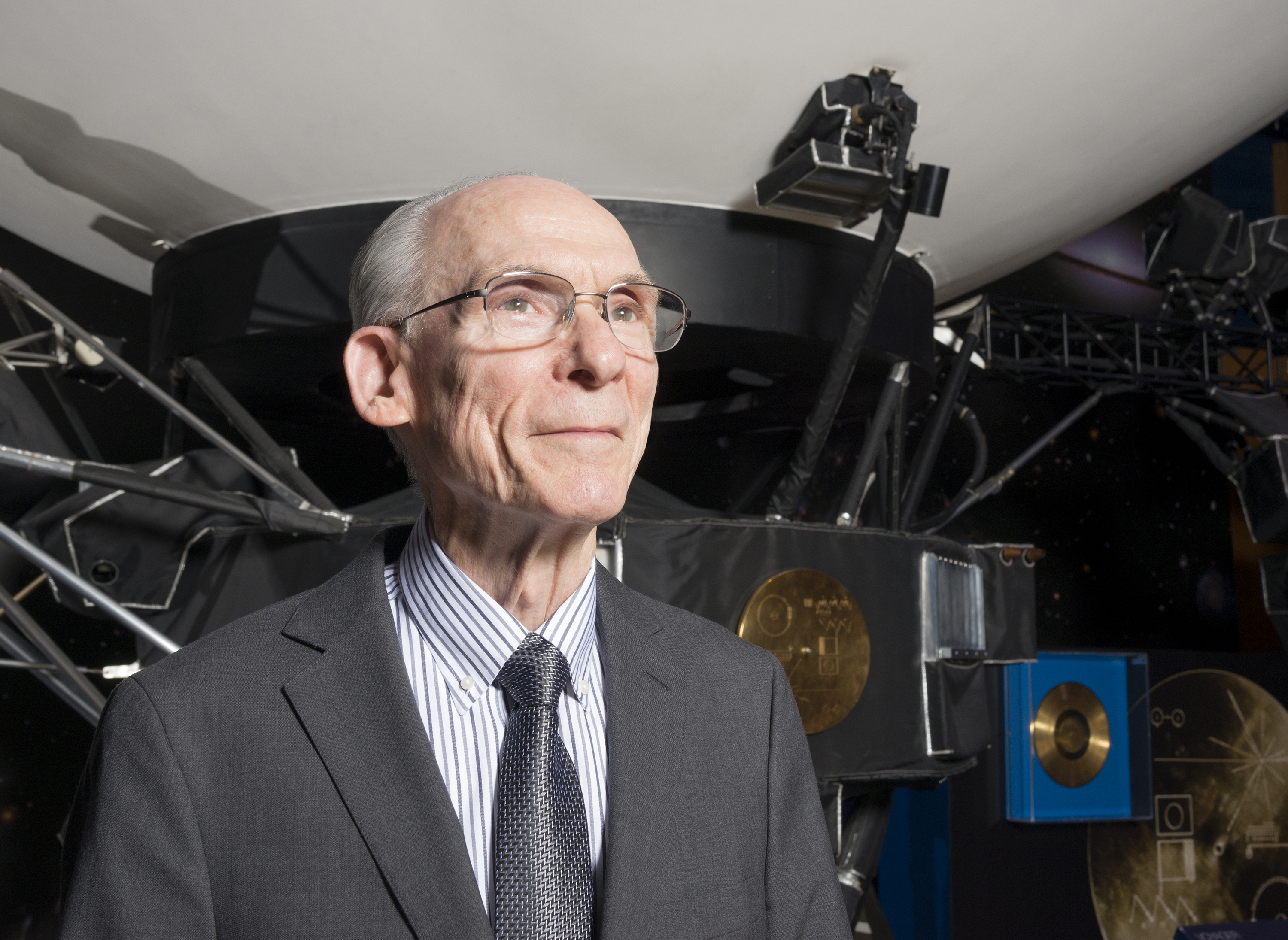
Edward Stone
Voyager Project Scientist
The Sun emits a steady flow of electrically charged particles called the solar wind. As the solar wind expands supersonically into space, it creates a magnetized bubble around the Sun, called the heliosphere. Eventually, the solar wind encounters the electrically charged particles and magnetic field in the interstellar gas. The boundary created between the solar wind and interstellar gas is the heliopause. Before the spacecraft reach the heliopause, they will pass through the termination shock -- the zone in which the solar wind abruptly slows down from supersonic to subsonic speed.
Reaching the termination shock and heliopause will be major milestones for the spacecraft because no one has been there before and the Voyagers will gather the first direct evidence of their structure. Encountering the termination shock and heliopause has been a long-sought goal for many space physicists, and exactly where these two boundaries are located and what they are like still remains a mystery.
"Based on current data from the Voyager cosmic ray subsystem, we are predicting the termination shock to be in the range of 62 to 90 astronomical units (AU) from the Sun. Most 'consensus' estimates are currently converging on about 85 AU. Voyager 1 is currently at about 67 AU and moving outwards at 3.5 AU per year, so I would expect crossing the termination shock sometime before the end of 2003," said Dr. Alan Cummings, a co- investigator on the cosmic ray subsystem at the California Institute of Technology.
"Based on a radio emission event detected by the Voyager 1 and 2 plasma wave instruments in 1992, we estimate that the heliopause is located at 110 to 160 AU from the Sun," said Dr. Donald A. Gurnett, principal investigator on the plasma wave subsystem at the University of Iowa. (One AU is equal to 150 million kilometers, or 93 million miles, or the distance from the Earth to the Sun.)
"The low-energy charged particle instruments on the two spacecraft continue to detect ions and electrons accelerated at the Sun and at huge shock waves, tens of AU in radius, that are driven outward through the solar wind. During the past five years, we have observed marked variations in this ion population, but have yet to see clear evidence of the termination shock. We should always keep in mind that our theories may be incomplete and the shock may be a lot farther out than we think," said Dr. Stamatios M. Krimigis, principal investigator for the low energy charged particle subsystem at The Johns Hopkins University Applied Physics Laboratory.
Voyager 2 was launched first on Aug. 20, 1977 and Voyager 1 was launched a few weeks later on a faster trajectory on Sept. 5. Initially both spacecraft were only supposed to explore two planets -- Jupiter and Saturn. But the incredible success of those two first encounters and the good health of the spacecraft prompted NASA to extend Voyager 2's mission on to Uranus and Neptune. As the spacecraft flew across the solar system, remote-control reprogramming has given the Voyagers greater capabilities than they possessed when they left the Earth.
There are four other science instruments that are still functioning and collecting data as part of the Voyager Interstellar Mission. The plasma subsystem measures the protons in the solar wind. "Our instrument has recently observed a slow, year-long increase in the speed of the solar wind which peaked in late 1996, and we are now observing a slow decrease in solar wind velocity," said Dr. John Richardson, of the Massachusetts Institute of Technology, principal investigator on the plasma subsystem. "We think the velocity peak coincided with the recent solar minimum. As we approach the solar maximum in 2000 the solar wind pressure should decrease, which will result in the termination shock and heliopause moving inward towards the Voyager spacecraft."
The magnetometer on board the Voyagers measures the magnetic fields that are carried out into interplanetary space by the solar wind. The Voyagers are currently measuring the weakest interplanetary magnetic fields ever detected and those magnetic fields being measured are responsive to charged particles that cannot be detected directly by any other instruments on the spacecraft, according to Dr. Norman Ness, principal investigator on the magnetometer subsystem at the Bartol Research Institute, University of Delaware.
Other science instruments still collecting data include the planetary radio astronomy subsystem and the ultraviolet spectrometer subsystem.
Voyager 1 encountered Jupiter on March 5, 1979, and Saturn on November 12, 1980 and then, because its trajectory was designed to fly close to Saturn's large moon Titan, Voyager 1's path was bent northward by Saturn's gravity, sending the spacecraft out of the ecliptic plane, the plane in which all the planets except Pluto orbit the Sun. Voyager 2 arrived at Jupiter on July 9, 1979, and Saturn on August 25, 1981, and was then sent on to Uranus on January 25, 1986 and Neptune on August 25, 1989. Neptune's gravity bent Voyager 2's path southward, sending it out of the ecliptic plane as well and on toward interstellar space.
Both spacecraft have enough electrical power and attitude control propellant to continue operating until about 2020, when the available electrical power will no longer support science instrument operation. Spacecraft electrical power is supplied by Radioisotope Thermoelectric Generators (RTGs) that provided approximately 470 watts power at launch. Due to the natural radioactive decay of the plutonium fuel source, the electrical energy provided by the RTGs is continually declining. At the beginning of 1997, the power generated by Voyager 1 had dropped to 334 watts and to 336 watts for Voyager 2. Both of these power levels represent better performance than had been predicted before launch.
The Voyagers are now so far from home that it takes nine hours for a radio signal traveling at the speed of light to reach the spacecraft. Science data are returned to Earth in real-time to the 34-meter Deep Space Network (DSN) antennas located in California, Australia and Spain. Voyager 1 will pass the Pioneer 10 spacecraft in January 1998 to become the most distant human- made object in our solar system.
Voyager 1 is currently 10.1 billion kilometers (6.3 billion miles) from Earth, having traveled 11.9 billion kilometers (7.4 billion miles) since its launch. The Voyager 1 spacecraft is departing the solar system at a speed of 17.4 kilometers per second (39,000 miles per hour).
Voyager 2 is currently 7.9 billion kilometers (4.9 billion miles) from Earth, having traveled 11.3 billion kilometers (6.9 billion miles) since its launch. The Voyager 2 spacecraft is departing the solar system at a speed of 15.9 kilometers per second (35,000 miles per hour).
JPL, a division of the California Institute of Technology, manages the Voyager Interstellar Mission for NASA's Office of Space Science, Washington, D. C.

- The Contents
- The Making of
- Where Are They Now
- Frequently Asked Questions
- Q & A with Ed Stone
golden record
Where are they now.
- frequently asked questions
- Q&A with Ed Stone
Mission Status
Instrument status.

Where are the Voyagers now?
To learn more about Voyager, zoom in and give the spacecraft a spin. View the full interactive experience at Eyes on the Solar System . Credit: NASA/JPL-Caltech
View Voyager
Space Flight Operations Schedule (SFOS)
SFOS files showing Voyager activity on Deep Space Network (DSN)
2024 Tracking Schedule
2023 tracking schedule, 2022 tracking schedule, 2021 tracking schedule, 2020 tracking schedule, 2019 tracking schedule, 2018 tracking schedule, 2017 tracking schedule, 2016 tracking schedule, 2015 tracking schedule, 2014 tracking schedule, 2013 tracking schedule, 2012 tracking schedule, 2011 tracking schedule, 2010 tracking schedule, 2009 tracking schedule, 2008 tracking schedule, 2007 tracking schedule, 2006 tracking schedule, 2005 tracking schedule, 2004 tracking schedule, 2003 tracking schedule, 2002 tracking schedule, 2001 tracking schedule, 2000 tracking schedule, 1999 tracking schedule, 1998 tracking schedule, 1997 tracking schedule, 1996 tracking schedule, 1995 tracking schedule, 1994 tracking schedule.
Five Things About NASA's Voyager Mission

Here are five things you should know about NASA's twin Voyager 1 and 2 spacecraft, the longest continuously-operating spacecraft in deep space.
News Media Contact
Courtney O'Connor
818-354-2274

The remarkable twin Voyager spacecraft continue to explore the outer reaches of the solar system decades after they completed their surveys of the Outer Planets. Launched in 1977 (September 5 for Voyager 1 (V1) and August 20 for Voyager 2 (V2), whose trajectory took it past Jupiter after Voyager 1), the spacecraft pair made many fundamental discoveries as they flew past Jupiter (March 1979 for V1, July 1979 for V2) and Saturn (November 1980 for V1, August 1981 for V2). The path of Voyager 2 past Saturn was targeted so that it continued within the plane of the solar system, allowing it to become the first spacecraft to visit Uranus (January 1986) and Neptune (August 1989). Following the Neptune encounter, both spacecraft started a new phase of exploration under the intriguing title of the Voyager Interstellar Mission.
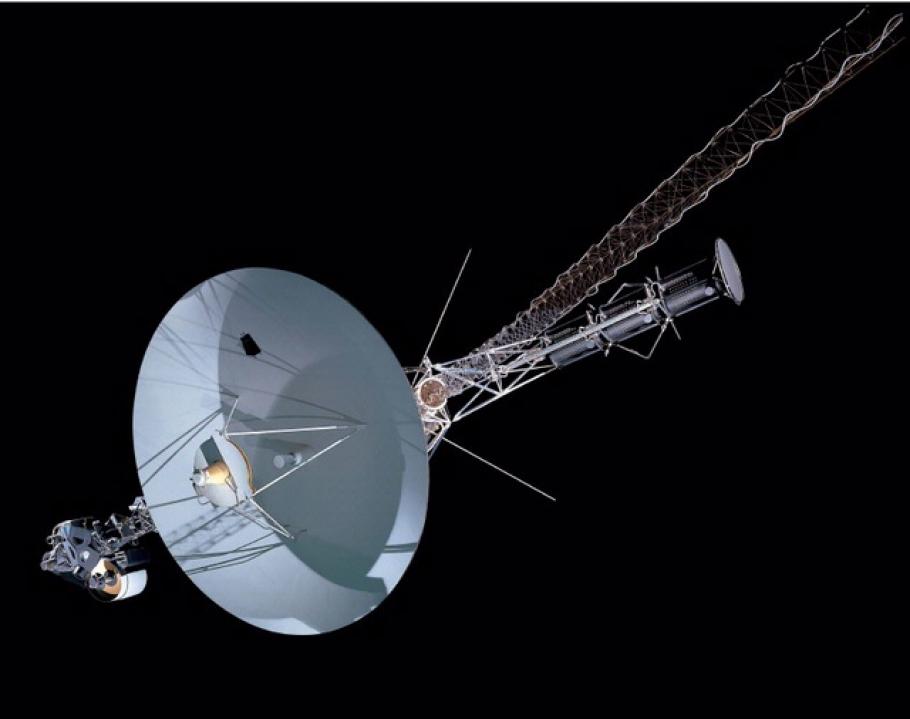
Five instruments continue to collect important measurements of magnetic fields, plasmas, and charged particles as both spacecraft explore different portions of the solar system beyond the orbits of the planets. Voyager 1 is now more than 118 astronomical units (one AU is equal to the average orbital distance of Earth from the Sun) distant from the sun, traveling at a speed (relative to the sun) of 17.1 kilometers per second (10.6 miles per second). Voyager 2 is now more than 96 AU from the sun, traveling at a speed of 15.5 kilometers per second (9.6 miles per second). Both spacecraft are moving considerably faster than Pioneers 10 and 11, two earlier spacecraft that became the first robotic visitors to fly past Jupiter and Saturn in the mid-70s.
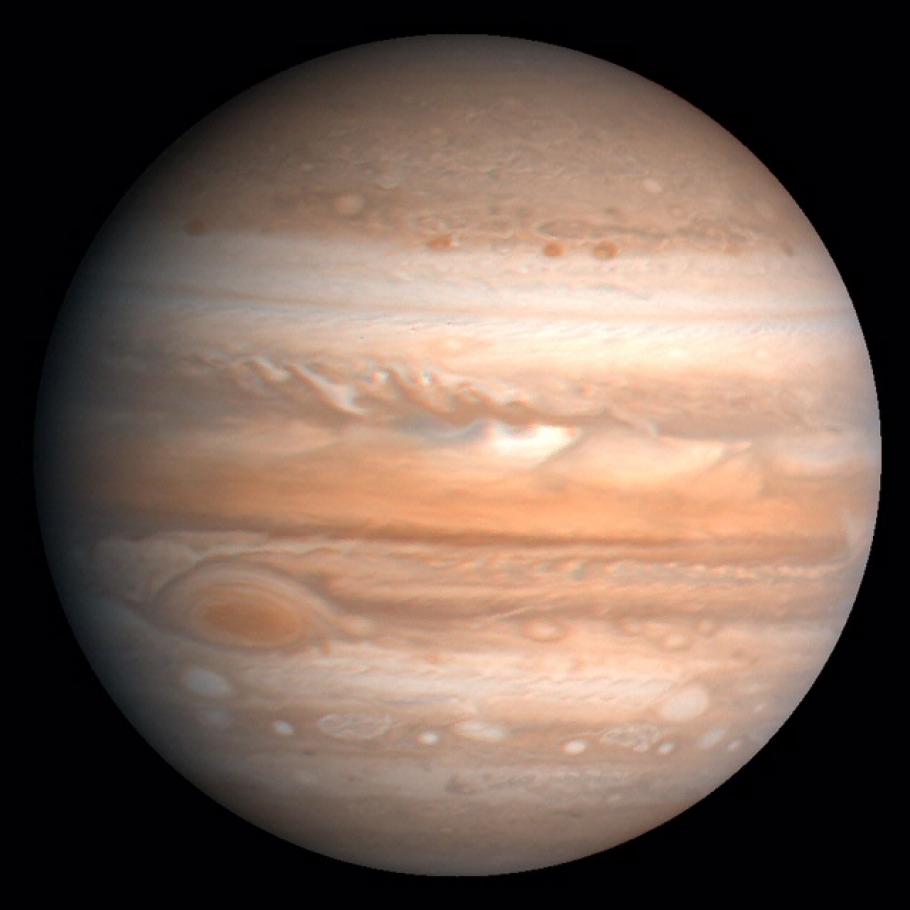
This processed color image of Jupiter was produced in 1990 by the U.S. Geological Survey from a Voyager image captured in 1979. The colors have been enhanced to bring out detail. Zones of light-colored, ascending clouds alternate with bands of dark, descending clouds. The clouds travel around the planet in alternating eastward and westward belts at speeds of up to 540 kilometers per hour. Tremendous storms as big as Earthly continents surge around the planet. The Great Red Spot (oval shape toward the lower-left) is an enormous anticyclonic storm that drifts along its belt, eventually circling the entire planet.
As seen in the night sky at Earth, Voyager 1 is within the confines of the constellation Ophiuchus, only slightly above the celestial equator; no telescope can see it, but radio contact is expected to be maintained for at least the next ten years. Voyager 2 is within the bounds of the constellation Telescopium (which somehow sounds quite appropriate) in the far southern night sky.
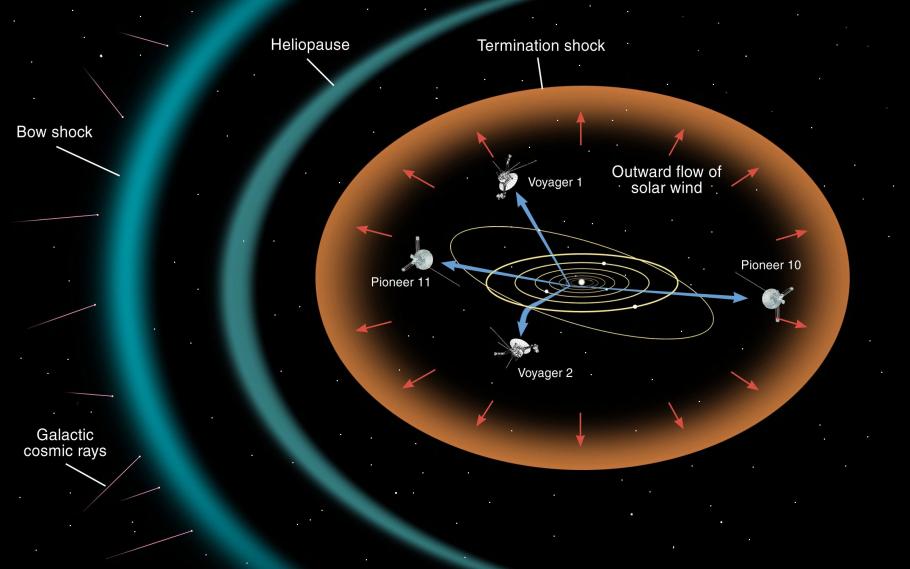
Both spacecraft have already passed something called the Termination Shock † (December 2004 for V1, August 2007 for V2), where the solar wind slows as it starts to interact with the particles and fields present between the stars. It is expected that both spacecraft will encounter the Heliopause, where the solar wind ceases as true interstellar space begins, from 10 to 20 years after crossing the Termination Shock. Theories exist for what should be present in interstellar space, but the Voyagers will become the first man-made objects to go beyond the influences of the Sun, hopefully returning the first measurements of what it is like out there. Each spacecraft is carrying a metal record with encoded sounds and sights from Earth, along with the needle needed to read the recordings, and simplified instructions for where the spacecraft came from, in case they are eventually discovered by intelligent extra-terrestrials.
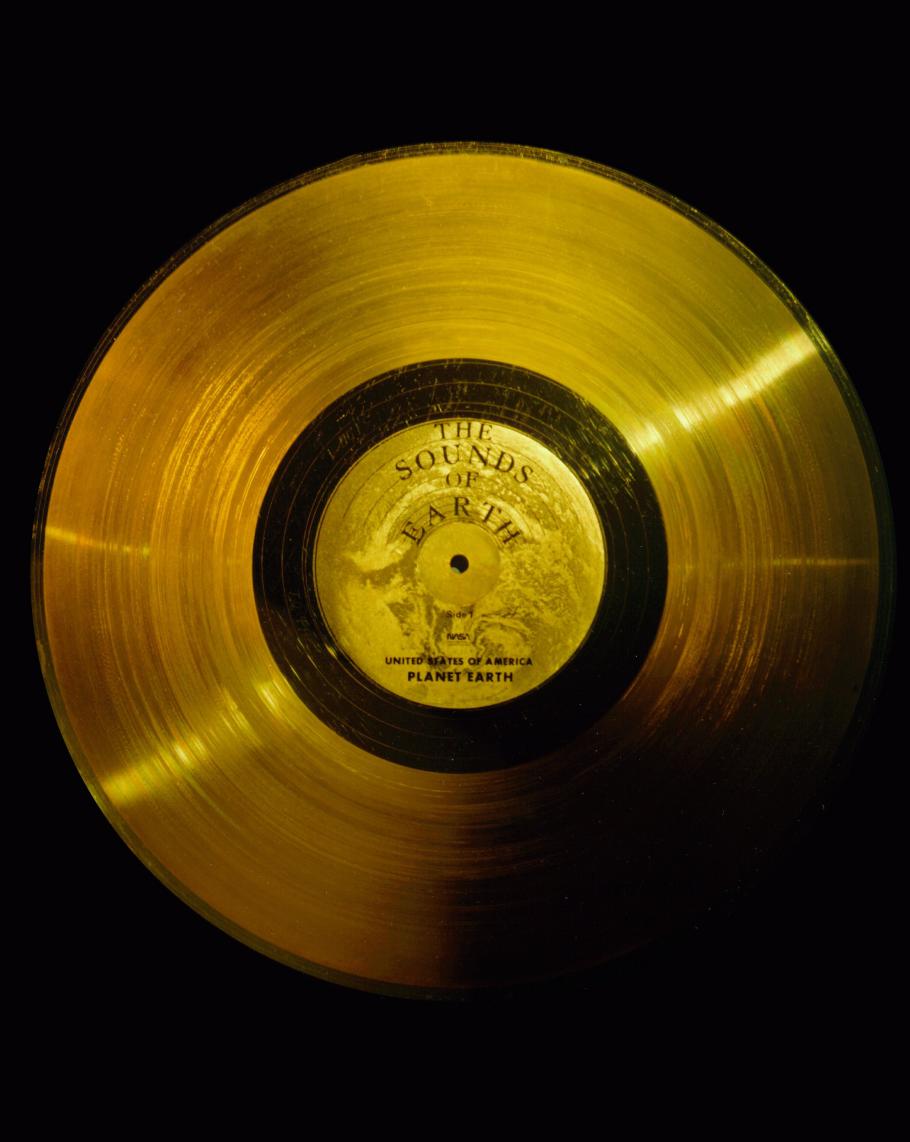
Keep track of the Voyager spacecraft on the official Voyager Interstellar Mission website or follow @NASAVoyager2 on Twitter. † The sun ejects a continuous stream of charged particles (electrons, protons, etc) that is collectively termed the solar wind. The particles are traveling extremely fast and are dense enough to form a very tenuous atmosphere; the heliosphere represents the volume of space where the effects of the solar wind dominate over those of particles in interstellar space. The solar wind particles are moving very much faster than the local speed of sound represented by their low volume density. When the particles begin to interact with interstellar particles and fields (the interaction can be either physically running into other particles or experiencing an electromagnetic force resulting from a charged particle moving within a magnetic field), then they start to slow down. The point at which they become subsonic (rather than their normal hypersonic speed) is the Termination Shock.
We rely on the generous support of donors, sponsors, members, and other benefactors to share the history and impact of aviation and spaceflight, educate the public, and inspire future generations. With your help, we can continue to preserve and safeguard the world’s most comprehensive collection of artifacts representing the great achievements of flight and space exploration.
- Get Involved
- Host an Event
Thank you. You have successfully signed up for our newsletter.
Error message, sorry, there was a problem. please ensure your details are valid and try again..
- Free Timed-Entry Passes Required
- Terms of Use
NASA Hears From Voyager 1, the Most Distant Spacecraft From Earth, After Months of Quiet
NASA has finally heard back from Voyager 1 in a way that makes sense

This illustration provided by NASA depicts Voyager 1. The most distant spacecraft from Earth stopped sending back understandable data in November 2023. Flight controllers traced the blank communication to a bad computer chip and rearranged the spacecraft’s coding to work around the trouble. In mid-April 2024, NASA’s Jet Propulsion Laboratory declared success after receiving good engineering updates. The team is still working to restore transmission of the science data. (NASA via AP)
CAPE CANAVERAL, Fla. (AP) — NASA has finally heard back from Voyager 1 again in a way that makes sense.
The most distant spacecraft from Earth stopped sending back understandable data last November. Flight controllers traced the blank communication to a bad computer chip and rearranged the spacecraft’s coding to work around the trouble.
NASA’s Jet Propulsion Laboratory in Southern California declared success after receiving good engineering updates late last week. The team is still working to restore transmission of the science data.
It takes 22 1/2 hours to send a signal to Voyager 1, more than 15 billion miles (24 billion kilometers) away in interstellar space. The signal travel time is double that for a round trip.
Contact was never lost, rather it was like making a phone call where you can’t hear the person on the other end, a JPL spokeswoman said Tuesday.
Launched in 1977 to study Jupiter and Saturn, Voyager 1 has been exploring interstellar space — the space between star systems — since 2012. Its twin, Voyager 2, is 12.6 billion miles (20 billion kilometers) away and still working fine.
Photos You Should See - April 2024

The Associated Press Health and Science Department receives support from the Howard Hughes Medical Institute’s Science and Educational Media Group. The AP is solely responsible for all content.
Copyright 2024 The Associated Press . All rights reserved. This material may not be published, broadcast, rewritten or redistributed.
Join the Conversation
Tags: Associated Press , science
America 2024

Health News Bulletin
Stay informed on the latest news on health and COVID-19 from the editors at U.S. News & World Report.
Sign in to manage your newsletters »
Sign up to receive the latest updates from U.S News & World Report and our trusted partners and sponsors. By clicking submit, you are agreeing to our Terms and Conditions & Privacy Policy .
You May Also Like
The 10 worst presidents.
U.S. News Staff Feb. 23, 2024

Cartoons on President Donald Trump
Feb. 1, 2017, at 1:24 p.m.

Photos: Obama Behind the Scenes
April 8, 2022

Photos: Who Supports Joe Biden?
March 11, 2020

Nationwide Campus Protests Escalate
Laura Mannweiler April 30, 2024


What to Know: Trump Gag Order Violations
Lauren Camera April 30, 2024

Different jobs with med degree
Jarek Rutz April 30, 2024

Motion To Oust Johnson Dead On Arrival
Aneeta Mathur-Ashton April 30, 2024

Consumers Losing Confidence in Economy
Tim Smart April 30, 2024

Home Prices Rise, Defying Mortgage Rates

- Election 2024
- Entertainment
- Newsletters
- Photography
- Personal Finance
- AP Investigations
- AP Buyline Personal Finance
- AP Buyline Shopping
- Press Releases
- Israel-Hamas War
- Russia-Ukraine War
- Global elections
- Asia Pacific
- Latin America
- Middle East
- Election Results
- Delegate Tracker
- AP & Elections
- Auto Racing
- 2024 Paris Olympic Games
- Movie reviews
- Book reviews
- Personal finance
- Financial Markets
- Business Highlights
- Financial wellness
- Artificial Intelligence
- Social Media
NASA hears from Voyager 1, the most distant spacecraft from Earth, after months of quiet
This illustration provided by NASA depicts Voyager 1. The most distant spacecraft from Earth stopped sending back understandable data in November 2023. Flight controllers traced the blank communication to a bad computer chip and rearranged the spacecraft’s coding to work around the trouble. In mid-April 2024, NASA’s Jet Propulsion Laboratory declared success after receiving good engineering updates. The team is still working to restore transmission of the science data. (NASA via AP)
- Copy Link copied
CAPE CANAVERAL, Fla. (AP) — NASA has finally heard back from Voyager 1 again in a way that makes sense.
The most distant spacecraft from Earth stopped sending back understandable data last November. Flight controllers traced the blank communication to a bad computer chip and rearranged the spacecraft’s coding to work around the trouble.
NASA’s Jet Propulsion Laboratory in Southern California declared success after receiving good engineering updates late last week. The team is still working to restore transmission of the science data.
It takes 22 1/2 hours to send a signal to Voyager 1, more than 15 billion miles (24 billion kilometers) away in interstellar space. The signal travel time is double that for a round trip.
Contact was never lost, rather it was like making a phone call where you can’t hear the person on the other end, a JPL spokeswoman said Tuesday.
Launched in 1977 to study Jupiter and Saturn, Voyager 1 has been exploring interstellar space — the space between star systems — since 2012. Its twin, Voyager 2, is 12.6 billion miles (20 billion kilometers) away and still working fine.
The Associated Press Health and Science Department receives support from the Howard Hughes Medical Institute’s Science and Educational Media Group. The AP is solely responsible for all content.
share this!
April 22, 2024
This article has been reviewed according to Science X's editorial process and policies . Editors have highlighted the following attributes while ensuring the content's credibility:
fact-checked
trusted source
NASA's Voyager 1 resumes sending engineering updates to Earth

For the first time since November, NASA's Voyager 1 spacecraft is returning usable data about the health and status of its onboard engineering systems. The next step is to enable the spacecraft to begin returning science data again. The probe and its twin, Voyager 2, are the only spacecraft to ever fly in interstellar space (the space between stars).
Voyager 1 stopped sending readable science and engineering data back to Earth on Nov. 14, 2023, even though mission controllers could tell the spacecraft was still receiving their commands and otherwise operating normally. In March, the Voyager engineering team at NASA's Jet Propulsion Laboratory in Southern California confirmed that the issue was tied to one of the spacecraft's three onboard computers, called the flight data subsystem (FDS). The FDS is responsible for packaging the science and engineering data before it's sent to Earth.
The team discovered that a single chip responsible for storing a portion of the FDS memory—including some of the FDS computer's software code—isn't working. The loss of that code rendered the science and engineering data unusable. Unable to repair the chip, the team decided to place the affected code elsewhere in the FDS memory. But no single location is large enough to hold the section of code in its entirety.
So they devised a plan to divide the affected code into sections and store those sections in different places in the FDS. To make this plan work, they also needed to adjust those code sections to ensure, for example, that they all still function as a whole. Any references to the location of that code in other parts of the FDS memory needed to be updated as well.

The team started by singling out the code responsible for packaging the spacecraft's engineering data. They sent it to its new location in the FDS memory on April 18. A radio signal takes about 22.5 hours to reach Voyager 1, which is over 15 billion miles (24 billion kilometers) from Earth, and another 22.5 hours for a signal to come back to Earth. When the mission flight team heard back from the spacecraft on April 20, they saw that the modification had worked: For the first time in five months, they were able to check the health and status of the spacecraft.
During the coming weeks, the team will relocate and adjust the other affected portions of the FDS software. These include the portions that will start returning science data.
Voyager 2 continues to operate normally. Launched over 46 years ago, the twin Voyager spacecraft are the longest-running and most distant spacecraft in history. Before the start of their interstellar exploration, both probes flew by Saturn and Jupiter, and Voyager 2 flew by Uranus and Neptune.
Provided by NASA
Explore further
Feedback to editors

Study uncovers the secret of long-lived stem cells
2 hours ago

Scientists show that ancient village adapted to drought, rising seas
3 hours ago

How polyps of the moon jellyfish repel viral attacks on their microbiome
4 hours ago

Organic electrochemical transistors: Scientists solve chemical mystery at the interface of biology and technology

Activity in a room stirs up nanoparticles left over from consumer sprays, study shows

Study dispels myth that purebred dogs are more prone to health problems
5 hours ago

Study shows climate change and mercury pollution stressed plants for millions of years
6 hours ago

Exploiting disorder to harvest heat energy: The potentialities of 2D magnets for thermoelectric applications

Citizen scientists help discover record-breaking exoplanet in binary star system

Novel calculations peg age of 'baby' asteroid
7 hours ago
Relevant PhysicsForums posts
Documenting the setup of my new telescope.
Apr 28, 2024
Quasi-Moons
Need help simplifying standard error formula for redshift.
Apr 27, 2024
Our Beautiful Universe - Photos and Videos
Apr 25, 2024
Solar Activity and Space Weather Update thread
'devil' comet visible tonight 21.04.24.
More from Astronomy and Astrophysics
Related Stories

Engineers working to resolve issue with Voyager 1 computer
Dec 13, 2023

NASA hears signal from Voyager 2 spacecraft after mistakenly cutting contact
Aug 1, 2023

NASA listens for Voyager 2 spacecraft after wrong command cuts contact
Jul 31, 2023

NASA's Voyager team focuses on software patch, thrusters
Oct 20, 2023

NASA's Voyager will do more science with new power strategy
Apr 27, 2023

Engineers investigating NASA's Voyager 1 telemetry data
May 18, 2022
Recommended for you

Japan's moon lander wasn't built to survive a weekslong lunar night. It's still going after 3
Apr 24, 2024

Simulated microgravity affects sleep and physiological rhythms, study finds
Apr 22, 2024

'Tube map' around planets and moons made possible by knot theory
Apr 17, 2024

NASA's Ingenuity Mars helicopter team says goodbye—for now

NASA confirms mystery object that crashed through roof of Florida home came from space station
Apr 16, 2024

NASA is seeking a faster, cheaper way to bring Mars samples to Earth
Let us know if there is a problem with our content.
Use this form if you have come across a typo, inaccuracy or would like to send an edit request for the content on this page. For general inquiries, please use our contact form . For general feedback, use the public comments section below (please adhere to guidelines ).
Please select the most appropriate category to facilitate processing of your request
Thank you for taking time to provide your feedback to the editors.
Your feedback is important to us. However, we do not guarantee individual replies due to the high volume of messages.
E-mail the story
Your email address is used only to let the recipient know who sent the email. Neither your address nor the recipient's address will be used for any other purpose. The information you enter will appear in your e-mail message and is not retained by Phys.org in any form.
Newsletter sign up
Get weekly and/or daily updates delivered to your inbox. You can unsubscribe at any time and we'll never share your details to third parties.
More information Privacy policy
Donate and enjoy an ad-free experience
We keep our content available to everyone. Consider supporting Science X's mission by getting a premium account.
E-mail newsletter
Whereis > NSW > Voyager Point
Map of Voyager Point, NSW 2172

Voyager Point is a small suburb, in South Western Sydney in the state of New South Wales, Australia. Voyager Point is located 25 kilometres (35 min) south of the Sydney central business district, in the local government area of the City of Liverpool. The only adjacent suburbs are Sandy Point, Holsworthy and Pleasure Point. Milperra, Panania and East Hills are located on the opposite bank of the Georges River. In the 2016 census, Voyager Point recorded a population of 1668 people.
Popular businesses & services in Voyager Point
Marriage celebrants, air conditioning installation & service, bathroom renovations & designs, cake & pastry shops, computer repairs, service & upgrades, concrete contractors, drainage & drain contractors, electricians & electrical contractors, finance brokers, graphic designers, hot water systems, mechanics & motor engineers, photographers--portrait, pipe lining & coating, plumbers & gas fitters, real estate development, tv antenna services, please select a letter above to browse businesses and services in voyager point, streets in voyager point, angophora ct, bullrush cr, buxifolia ct, cambrian av, challenger st, creekwood dr, goodenia ct, lomandra ct, mirbelia ct, punctata ct, scribbly gum ct, snowflake st, warraburra wy, woollsia ct.
Set your home and work address and access your most frequently used addresses easily.
Browse : ACT | NSW | NT | QLD | SA | TAS | VIC | WA
- Add your business
- Legal & Privacy
- White Pages
- Yellow Pages
- About Thryv Australia
- FanNation FanNation FanNation
- Swimsuit SI Swimsuit SI Swimsuit
- Sportsbook SI Sportsbook SI Sportsbook
- Tickets SI Tickets SI Tickets
- Shop SI Shop SI Shop
- Free Agency
- WNBA WNBA WNBA
- Home Home Home
- Scores Scores Scores
- Schedule Schedule Schedule
- Standings Standings Standings
- Stats Stats Statistics

© David Butler II-USA TODAY Sports
Diana Taurasi Calls WNBA Fans ‘Sensitive,’ Doubles Down on Critique of Caitlin Clark
- Author: Kristen Wong
In this story:
The hype over “The GOAT” vs. “The Rook” game — this summer’s marquee matchup between Phoenix Mercury’s Diana Taurasi and Indiana Fever’s Caitlin Clark — only continues to grow as the start of the WNBA season nears.
Taurasi, a former No. 1 pick by Phoenix in 2004, drew the ire of Clark’s supporters earlier this month for her blunt comments regarding the ex-Hawkeyes star’s imminent transition to the WNBA.
The Mercury veteran doubled down on those comments during Sunday’s preseason availability and called the new fans of the WNBA “sensitive.”
“The new fans are really sensitive these days and you can’t say anything,” said Taurasi. “It’s kind of like when you go from kindergarten to first grade there’s a learning adjustment, when you go from high school to college there’s a learning adjustment. I don’t think I said anything that wasn’t factually correct.”
#Mercury Diana Taurasi on Caitlin Clark coming into #wnba pic.twitter.com/Ff4cLurQmL — jeffmetcalfe (@jeffmetcalfe) April 28, 2024
Taurasi added, “Greatness is going to translate and she’s proven that in every level. I don’t see that being any different in the WNBA.”
Clark, the NCAA’s all-time top scorer and one of several highly touted rookies entering the league this year, will play Taurasi’s Mercury on June 30. The WNBA season officially begins on May 14.
During ESPN’s alternate broadcast of the women’s Final Four tilt between Iowa and UConn, Taurasi initially set off Clark’s fans with a seemingly disparaging comment on Clark’s future WNBA career .
“Reality is coming,” Taurasi said on April 6. “You see it on the NBA side, and you’re going to see it on this side. You look superhuman playing against 18-year-olds, but you’re going to come play with some grown women that have been playing professional basketball for a long time.”
Latest News

A’ja Wilson Captured Candace Parker’s Perfect Reaction to South Carolina’s Dramatic Win vs. Tennessee

How Caitlin Clark Declaring for WNBA Draft Impacted Indiana Fever’s Ticket Prices

Indiana Fever Dropped Not-So-Subtle Hint for No. 1 WNBA Draft Pick, and Caitlin Clark Loved It

Sue Bird Makes WNBA Prediction for Iowa Star Caitlin Clark

Steph Curry Narrowly Defeats Sabrina Ionescu in All-Star Three-Point Shootout
Army West Point

#6 Lehigh (Quarterfinals)

Women's Lacrosse Defeated in Double Overtime in Patriot League Quarterfinals to #6 Lehigh
April 29, 2024 | Women's Lacrosse
Advertisement
Pennsylvania 12th Congressional District Primary Election Results
- Share full article
Representative Summer Lee, a progressive Democrat who was first elected in 2022 and has been outspoken in support of a cease-fire in Gaza, has a pro-Israel challenger, Bhavini Patel.
Democratic Primary
Summer lee wins the democratic primary..
Race called by The Associated Press.
Democratic Primary race called
Results by county
Republican primary.
Republican Primary race called
2024 Primary Results
- Connecticut
- Massachusetts
- Mississippi
- New Hampshire
- North Carolina
- North Dakota
- Pennsylvania
- Rhode Island
- South Carolina
- Washington, D.C.
University of Wisconsin - Stevens Point Athletics

- Box Score 1
- Box Score 2

W : Schneider, Joe (2-0) L : Nate Melnikoff (1-1)
W : Alex Redman (2-2) L : Pickering, Casey (5-2) S : Owen Deprez (2)
Game Recap: Baseball | 4/27/2024 11:15:00 PM
Baseball Splits Again with 13th-Ranked UWL

Thanks for visiting !
The use of software that blocks ads hinders our ability to serve you the content you came here to enjoy.
We ask that you consider turning off your ad blocker so we can deliver you the best experience possible while you are here.
Thank you for your support!
- Entertainment
- Miscellaneous

14 Interesting Facts About Moscow
Moscow holds a spacial place in the World’s Imagination. Opulent, breathtaking and Grandiose, Moscow has been at the epicenter of some of the history’s most pivotal moments. Moscow brags about the stories of triumphs, tragedy, and innovation and echoes the stories of legendary Tsars and literary great political revolution and international space race that changed the world forever. Today Moscow is thoroughly modern and has a population over 11 million. Moscow is one of the world’s highest concentration of Billionaires. It boasts Red Square, a perfect place to let you know the Moscow’s Past. If you want to visit this beautiful and historical city, go through these some amazing and interesting facts about this The Forty Forties, Moscow:

image: cornerstone-group.com
1. Named After Moskva River

Moscow has got its name from the river that runs through it, the Moskva. “Moscow” meant “wet.” source: goeasteurope.about.com, image: ladaray.files.wordpress.com
2. Moscow’s Most Famous Address

Truly the heart and soul of Russia, the Red Square is the most popular spot in Moscow. It speaks a lot about the long and fascinating history of the country. Popularly, it was also known as ‘Fire Square’, reflecting the number of times medieval Moscow burned. The Red Square is a fascinating site of fierce fighting and brutal history; remarkably a must visit in Moscow. source: moscow.info, image: holidayextras.co.uk
3. Too Big To Be A City!
Moscow is the largest European city having an area of 2511 square km and with a population of 12 million. This is usually the population of various countries such as Norway and Switzerland. Technically, Moscow is so huge that it deserves all rights to be a country. source: friendlylocalguides.com
4. City Of Billionaires
Moscow boasts one of the largest numbers of billionaires in the world. According to the Forbes, there are 84 billionaires in the city with the total wealth of 367 billion dollars. source: friendlylocalguides.com
5. The Ancient Kremlin Fort

Kremlin, an ancient fortress in Moscow, was built around 1331 and is today used as the residence of the Russian president. It is a significant historic building in the city. source: interestingfunfacts.com, image: hellomoskva.com
6. The Seven Sisters
In Moscow, there are seven buildings that look exactly the same. They are two hotels, two administrative buildings, two blocks of flats, and the Moscow State University. Interestingly, they are called “Stalin’s skyscrapers” or the “Seven Sisters.” These buildings are
- Moscow State University
- Hotel Ukraina
- Ministry of Foreign Affairs
- Leningradskaya Hotel
- Kotelnicheskaya Embankment Building
- Kudrinskaya Square Building
- Red Gates Administrative Building
source: i-love-moscow.com
7. The Most Beautiful Underground On Earth

The Moscow Metro is considered as the most beautiful underground on the earth. It’s not just a convenient way to move around the city, but also is one of its main sights, a cultural spot, where even guided tours are held annually. source: studyinrussia.ru, image: d.ibtimes.co.uk, image: i.ytimg.com
8. “Moscow Doesn’t Believe In Tears”
Hundreds of years ago, Russian cities had to pay a great tribute to Moscow. To avoid or delay the payment, the petitioners tried to persuade the Emperor to extend the repayment period. On the contrary, the emperor didn’t believe in tears. From there, a very famous Russian saying Moscow doesn’t believe in tears started. source: friendlylocalguides.com
9. City Of Park

Moscow is the city of beautiful parks with no less than 120 garden squares in total. It is a green city with 40 percent of its territory covered by greenery. source: studyinrussia.ru, image: psimonmyway.com, image: cities-of-europe.com
10. Don’t Believe In Myth
There is a huge myth about the brutally cold weather in Moscow, Russia. This is not correct. The climate is temperate. The city has the mild summer season. source: i-love-moscow.com
11. Least Unemployment Rate!
Moscow has recorded the lowest unemployment rate in Russia that is 1% as compared to the national figure of 7%. Thus, it makes Moscow a great city for finding employment. source: interestingfunfacts.com
12. The Highest In Europe
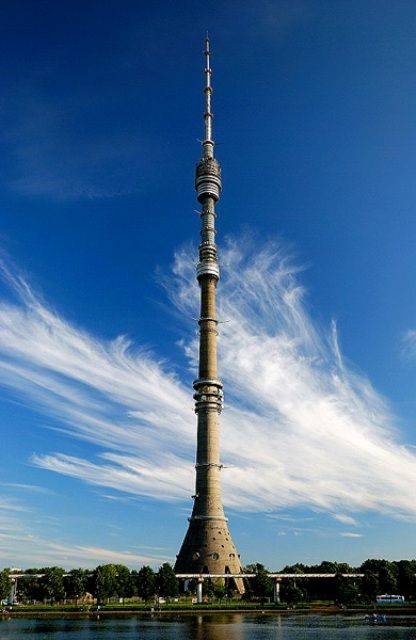
13. Read In Lenin Library

Lenin Library is the largest Library in Europe, with its 43 million objects storage (maps, sheet music, sound recordings, rare books, dissertations, newspapers). In the 1970s at the peak of the popularity of The Beatles, the library was tagged as the “Lennon Bitlioteka”. It was called the V. I. Lenin State Library of the USSR from 1925 until it was renamed as the Russian State Library in 1992. source: friendlylocalguides.com, image: theeuropeanlibrary.org
14. Don’t Miss Izmaylovsky Park

Izmailovo Park is one of the largest urban parks in the world; It has an area of 15.34 square kilometers or 1534 hectares. Izmaylovo Park is six times bigger than Central Park in New York, and 30 times bigger than the gorgeous Abramtsevo park, a famous Russian landmark in Moscow region. source: friendlylocalguides.com, image: i.ytimg.com
More from OhFact!

RELATED ARTICLES MORE FROM AUTHOR
29 amazing facts about bank of america, 26 interesting facts about meiji shrine, 34 amazing facts about slovakia, 22 amazing facts about tarahumara tribe, 16 interesting facts about matryoshka dolls, 19 lesser known facts about sentinel island, random posts, 17 interesting facts about alcohol, 18 interesting facts about sandra bullock, 12 interesting facts about titanosaurus, 16 interesting facts about papa john’s, 16 interesting facts about katie ledecky, popular posts.
- Privacy Policy

IMAGES
VIDEO
COMMENTS
The Voyager 1 probe is the most distant human-made object in existence. After a major effort to restore communication with it, NASA announced success this week. ... Voyager 2, which is 12.6 ...
The Voyager 1 and Voyager 2 probes launched in 1977 on a mission to study Jupiter and Saturn but continued onward through the outer reaches of the solar system. ... After a 12.3 billion-mile ...
Voyager 1 and 2, cruising along diverging paths, made history by crossing the heliopause in 2012 and 2018, respectively (SN: 9/12/13; SN: 12/10/18). At nearly 18 billion kilometers from the sun ...
Both Voyager 1 and Voyager 2 have reached "interstellar space" and each continue their unique journey deeper into the cosmos. ... 12.7 million miles 20.4 million kilometers 136 AU. Velocity with Respect to the Sun (est.) 38,2026.77 mph 16.9995 kps. 34,390.98 mph 15.3471 kps. One-Way Light Time.
Voyager 2 was the first to launch, with Voyager 1 following two weeks later. Both carried the famous " Golden Record ," a 12-inch gold-plated copper disc containing sounds and images portraying ...
How the Voyagers work . The two spacecraft are identical, each with a radio dish 3.7 meters (12 feet) across to transmit data back to Earth and a set of 16 thrusters to control their orientations and point their dishes toward Earth. The thrusters run on hydrazine fuel, but the electronic components of each spacecraft are powered by thermoelectric generators that run on plutonium.
The prime Voyager mission to Jupiter and Saturn brought Voyager 1 to Jupiter on March 5, 1979, and Saturn on November 12, 1980, followed by Voyager 2 to Jupiter on July 9, 1979, and Saturn on August 25, 1981. ... The intensity of the field is roughly comparable to that of Earth's, though it varies much more from point to point because of its ...
818-354-5011. 1991-1400. More than two years after Voyager 2 looked Neptune's Great Dark Spot in the eye and darted past the frozen surface of its moon Triton, both Voyager spacecraft are continuing to return data about interplanetary space and some of our stellar neighbors near the edges of the Milky Way.
Launched in 1977, the Voyager 2 spacecraft is more than 12 billion miles (20 billion kilometers) from Earth, using five science instruments to study interstellar space. To help keep those instruments operating despite a diminishing power supply, the aging spacecraft has begun using a small reservoir of backup power set aside as part of an ...
Voyager 1 encountered Jupiter on March 5, 1979, and Saturn on November 12, 1980 and then, because its trajectory was designed to fly close to Saturn's large moon Titan, Voyager 1's path was bent northward by Saturn's gravity, sending the spacecraft out of the ecliptic plane, the plane in which all the planets except Pluto orbit the Sun. Voyager ...
Voyager 2 entered interstellar space on November 5, 2018 and scientists hope to learn more about this region. Both spacecraft are still sending scientific information about their surroundings through the Deep Space Network, or DSN. The primary mission was the exploration of Jupiter and Saturn. After making a string of discoveries there — such ...
Note: Because Earth moves around the sun faster than Voyager 1 is speeding away from the inner solar system, the distance between Earth and the spacecraft actually decreases at certain times of year. ... (Nov. 12, 1998) Where are the Voyagers now? To learn more about Voyager, zoom in and give the spacecraft a spin.
5. Where No Spacecraft Has Gone Before. Voyager 1 has reached a distant point at the edge of our solar system, where the outward motion of solar wind ceases. The event is the latest milestone in Voyager 1's passage through the heliosheath, the outer shell of the sun's sphere of influence, before entering interstellar space.
Voyager 2 is now more than 96 AU from the sun, traveling at a speed of 15.5 kilometers per second (9.6 miles per second). Both spacecraft are moving considerably faster than Pioneers 10 and 11, two earlier spacecraft that became the first robotic visitors to fly past Jupiter and Saturn in the mid-70s. This processed color image of Jupiter was ...
Launched in 1977 to study Jupiter and Saturn, Voyager 1 has been exploring interstellar space — the space between star systems — since 2012. Its twin, Voyager 2, is 12.6 billion miles (20 ...
Its twin, Voyager 2, is 12.6 billion miles (20 billion kilometers) away and still working fine. READ MORE NASA is seeking a faster and cheaper way to bring Mars samples to Earth. As airplane makers struggle to meet demand, Morocco wants to become a manufacturing hub. European Space Agency adds 5 new astronauts in only fourth class since 1978. ...
Voyager 1 stopped sending readable science and engineering data back to Earth on Nov. 14, 2023, even though mission controllers could tell the spacecraft was still receiving their commands and ...
Pale Blue Dot is a photograph of Earth taken on February 14, 1990, by the Voyager 1 space probe from an unprecedented distance of approximately 6 billion kilometers (3.7 billion miles, 40.5 AU), as part of that day's Family Portrait series of images of the Solar System.. In the photograph, Earth's apparent size is less than a pixel; the planet appears as a tiny dot against the vastness of ...
On December 12, 2023, NASA announced that Voyager 1 's flight data system was unable to use its telemetry modulation unit, preventing it from transmitting scientific data. ... By this point, most space scientists had abandoned the hypothesis that a change in magnetic field direction must accompany a crossing of the heliopause; a new ...
"Counterpoint" is the 104th and tenth episode of the fifth season of Star Trek: Voyager. In this space science fiction television show, a spacecraft, the Federation's USS Voyager is stranded on the wrong side of the galaxy as it must slowly makes its way home to Earth. In this episode, Voyager and its crew encounter the Devore aliens, posing particularly difficult choices for the ship's ...
Property overview. 12 Warraburra Way, Voyager Point, NSW 2172 has a land size of 546 m². It is a house with 5 bedrooms, 3 bathrooms, and 2 parking spaces. Powered by.
Map of Voyager Point, NSW 2172. Voyager Point is a small suburb, in South Western Sydney in the state of New South Wales, Australia. Voyager Point is located 25 kilometres (35 min) south of the Sydney central business district, in the local government area of the City of Liverpool. The only adjacent suburbs are Sandy Point, Holsworthy and ...
The Mercury veteran doubled down on those comments during Sunday's preseason availability and called the new fans of the WNBA "sensitive." "The new fans are really sensitive these days and ...
WEST POINT, NY - Army West Point women's lacrosse (9-8, 7-2 Patriot League) fell in double overtime to sixth-seeded Lehigh (8-8, 3-6 Patriot League) by a score of 12-11. Emma Eberhardt scored the game-winner in double overtime on a two-woman up advantage after Gabby Schneider tied the game in the final minute of regulation to force the ovrtime periods.
Walking tour around Moscow-City.Thanks for watching!MY GEAR THAT I USEMinimalist Handheld SetupiPhone 11 128GB https://amzn.to/3zfqbboMic for Street https://...
Voyager Point is a small suburb, in South Western Sydney in the state of New South Wales, Australia.Voyager Point is located 25 kilometres (35 min) south of the Sydney central business district, in the local government area of the City of Liverpool.The only adjacent suburbs are Sandy Point, Holsworthy and Pleasure Point. Milperra, Panania and East Hills are located on the opposite bank of the ...
Pittsburgh Pittsburgh District 12 District 12. leader . Lee. By leader Size of lead . Results by county; County Lee Patel Total votes Percent of votes in % In; Allegheny : 61 % 39 % 95,742 >95% ...
Exclamation point. Icon of a triangle with exclamation point to signify a user should take note of something. Checkmark icon. Chevron-shaped icon used for navigational cues. Chevron-shaped icon used for navigational cues. A dash. Three dots. A cross shape. A polling checkmark. A ticket stub icon with solid fill. An outlined ticket stub icon ...
STEVENS POINT, Wis. - The UW-Stevens Point baseball team (22-12, 13-7) got another split against No. 13 UW-La Crosse (23-10, 12-8) on Saturday. The Pointers rallied for a 17-14 win in game one before coming up just short in an 8-7 loss in game two. Bradley Comer (Rhinelander, Wis./Rhinelander) had six hits on the day with an RBI in each game ...
12. The Highest In Europe Ostankino Tower is the T.V. and Radio tower situated in Moscow. It is the highest TV tower in Europe. It is 540.1 meters tall. source: Wikipedia, image: fullpicture.ru. 13. Read In Lenin Library . Russian State Library, Moscow. Lenin Library is the largest Library in Europe, with its 43 million objects storage (maps ...